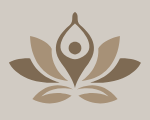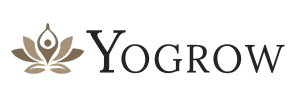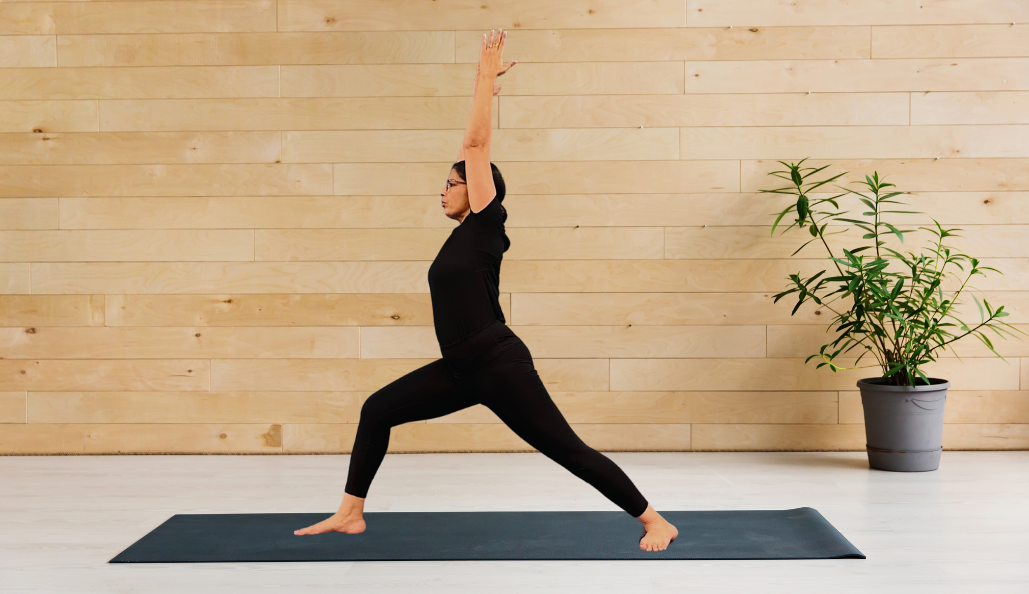Written by
admin
January 19, 2025
Yoga for Sedentary Lifestyle: Rejuvenate Your Body and Mind
In today’s fast-paced world, many of us lead sedentary lives—spending long hours at desks, enduring lengthy commutes, and relaxing in front of screens. This lifestyle often results in issues like poor posture, back pain, stiff joints, and mental fatigue, all of which can take a toll on our overall health and well-being.
Yoga provides a simple yet effective way to counter these negative effects. By incorporating yoga into your daily routine, you can improve flexibility, strengthen muscles, correct posture, and reduce stress. In this blog, we’ll explore yoga poses and practices designed to help you feel rejuvenated and balanced, even in the midst of a sedentary lifestyle.
Cat-Cow Stretch (Marjaryasana-Bitilasana)
The Cat-Cow Stretch is a simple yet effective yoga pose that warms up the spine and improves flexibility. It alternates between arching and rounding the back, helping to release tension in the neck, shoulders, and back. This stretch promotes spinal mobility, improves posture, and boosts circulation. It’s particularly beneficial for those with sedentary lifestyles or poor posture. Easy to practice, it helps reduce stiffness and discomfort caused by prolonged sitting. Adding the Cat-Cow Stretch to your daily routine can enhance overall well-being and physical alignment.
How to do it:
- Begin on all fours with your wrists aligned under your shoulders and your knees under your hips.
- Inhale as you drop your belly toward the floor, lifting your chest and tailbone (Cow Pose).
- Exhale as you round your back, tucking your chin to your chest and drawing your belly button toward your spine (Cat Pose).
- Continue to flow between these two poses for 10-15 rounds, focusing on your breath.
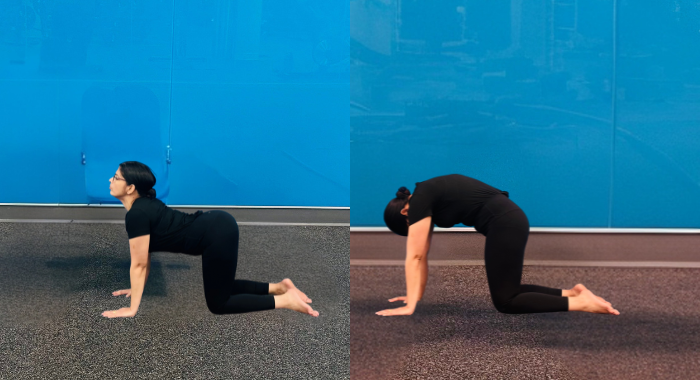
Benefits:
- Increases spinal flexibility and reduces stiffness.
- Relieves tension in the neck, shoulders, and back.
- Helps improve posture and mobility in the spine.
- Stimulates blood flow, helping to energize the body and reduce stiffness.
Downward-Facing Dog (Adho Mukha Svanasana)
Downward-Facing Dog, or Adho Mukha Svanasana, is a foundational yoga pose known for its versatility and full-body benefits. It provides a deep stretch to the hamstrings, calves, and shoulders while strengthening the arms, legs, and core. This pose promotes balance, alignment, and overall flexibility. It also helps elongate the spine and relieve tension in the back and neck. Suitable for all levels, it is a key component of many yoga routines. Practicing Downward-Facing Dog regularly enhances strength, flexibility, and relaxation.
How to do it:
- Start on all fours with your hands shoulder-width apart and feet hip-width apart.
- Tuck your toes and lift your hips toward the ceiling, forming an inverted “V” shape with your body.
- Press your heels toward the ground, and keep your arms extended while pressing your chest towards your thighs.
- Hold for 20-30 seconds, breathing deeply.
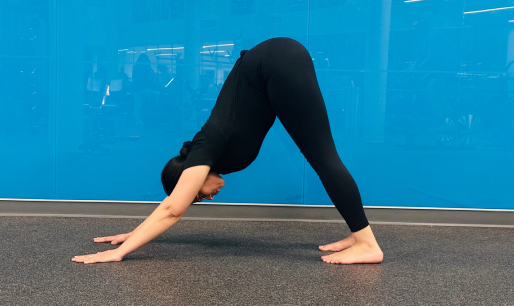
Benefits:
- Stretches the hamstrings, calves, and spine.
- Relieves tension in the lower back and neck.
- Energizes the body and improves blood circulation.
- Enhances overall body awareness and balance.
Seated Forward Fold (Paschimottanasana)
Seated Forward Fold, or Paschimottanasana, is a soothing and therapeutic yoga pose that provides a deep stretch to the entire back body, including the spine, hamstrings, and calves. This pose is highly effective for improving flexibility, enhancing posture, and releasing built-up tension. It also encourages relaxation and helps calm the mind, making it a great practice for reducing stress and anxiety. Ideal for those dealing with stiffness from prolonged sitting or physical exertion, it gently alleviates discomfort while promoting overall well-being. Incorporating Seated Forward Fold into your routine offers a perfect balance of physical stretch and mental relaxation.
How to do it:
- Sit on the floor with your legs extended straight in front of you.
- Inhale as you lengthen your spine, and exhale as you fold forward from the hips, reaching for your feet or ankles.
- Keep your chest open and try to deepen the stretch with each breath.
- Hold for 20-30 seconds, then slowly come back up.
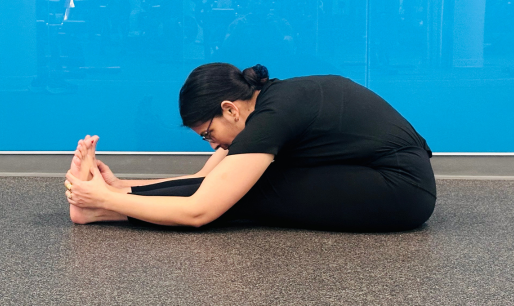
Benefits:
- Stretches the hamstrings, lower back, and calves.
- Reduces tension in the spine.
- Calms the mind and relieves stress.
- Enhances body awareness and promotes relaxation.
Bridge Pose (Setu Bandhasana)
Bridge Pose (Setu Bandhasana) is a dynamic yoga pose that stretches the chest, spine, and hips, while also strengthening the glutes, legs, and lower back. It’s highly effective for improving posture and releasing tension, especially in the lower back, making it a great counterpose for those who sit for long periods. This pose helps open the chest, encouraging deep breathing and promoting relaxation. By engaging the core and glutes, Bridge Pose also boosts stability and strengthens the lower body. It’s a versatile and energizing pose that enhances flexibility and strengthens key muscle groups.
How to do it:
- Lie on your back with your knees bent and feet flat on the floor, hip-width apart.
- Place your arms at your sides, palms facing down.
- Press your feet into the floor, lift your hips toward the ceiling, and engage your glutes and core.
- Hold for 20-30 seconds, then slowly lower your hips back down.
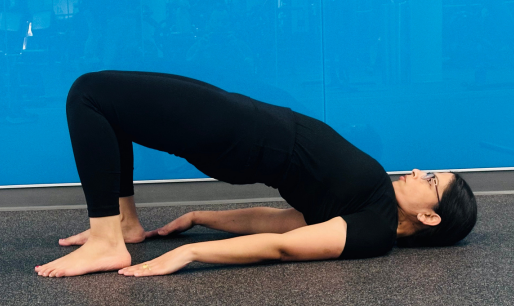
Benefits:
- Strengthens the lower back, glutes, and core muscles.
- Opens the chest and hip flexors.
- Improves posture and relieves tension from sitting.
- Stimulates blood flow and energizes the body.
Child’s Pose (Balasana)
Child's Pose (Balasana) is a deeply restful yoga posture that stretches the back, hips, and thighs, offering relief from tension. It’s known for its calming and grounding effects, making it an excellent resting pose between more challenging postures. Practicing Child’s Pose encourages mindfulness, helping you reconnect with your breath and center your body and mind. It’s often used at the start or end of a yoga session to promote relaxation and reduce stress. This gentle stretch also aids in calming the nervous system and provides a sense of mental clarity. It’s a restorative pose that supports both physical and emotional well-being.
How to do it:
- Kneel on the floor with your big toes touching and knees spread wide.
- Sit back on your heels, then lower your chest toward the floor and stretch your arms in front of you.
- Relax your forehead on the ground and breathe deeply.
- Hold for 1-2 minutes, allowing your body to relax.
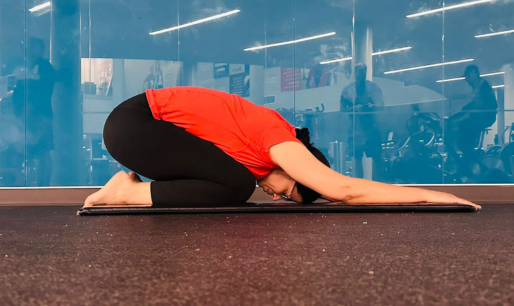
Benefits:
- Gently stretches the back, hips, and thighs.
- Helps release tension in the neck and shoulders.
- Calms the nervous system and reduces stress.
- Improves flexibility in the spine and hips.
Standing Forward Fold (Uttanasana)
Standing Forward Fold (Uttanasana) is a fundamental yoga pose that provides a deep stretch to the hamstrings, calves, and spine. This pose helps release built-up tension in the body, improving flexibility and promoting relaxation. It also encourages deep breathing, which aids in calming the mind and reducing stress. Uttanasana is ideal for relieving mental fatigue and anxiety while improving posture. Incorporating this pose into your practice can enhance overall flexibility and mental clarity. It’s a simple yet powerful way to feel grounded and energized.
How to do it:
- Stand with your feet hip-width apart.
- Inhale to lengthen your spine, then exhale and fold forward from your hips, bringing your chest toward your thighs.
- Allow your head to hang heavy, and place your hands on the floor or hold opposite elbows.
- Hold for 20-30 seconds, breathing deeply.

Benefits:
- Stretches the hamstrings, calves, and lower back.
- Helps improve flexibility and reduces tightness from prolonged sitting.
- Relieves tension and stress.
- Stimulates circulation and energizes the body.
Warrior I (Virabhadrasana I)
Warrior I (Virabhadrasana I) is a dynamic yoga pose that builds strength, stability, and mental focus. It stretches the legs, hips, and chest while strengthening the arms, legs, and core, making it an effective full-body pose. This powerful pose promotes a sense of confidence, determination, and resilience. Regular practice of Warrior I improves posture and flexibility, particularly in the hips and shoulders. It also enhances balance, coordination, and concentration, making it a vital part of any yoga practice. Incorporating Warrior I helps cultivate both physical strength and mental clarity.
How to do it:
- Step your left foot back, keeping your right knee bent at a 90-degree angle.
- Extend your arms overhead, keeping your shoulders relaxed.
- Square your hips forward and press through the back foot to feel a strong stretch in the hips, legs, and chest.
- Hold for 20-30 seconds, then switch sides.

Benefits:
- Strengthens the legs, hips, and arms.
- Improves posture and increases energy.
- Opens the chest and shoulders.
- Increases focus and concentration.
Reclining Twist (Supta Matsyendrasana)
Reclining Twist (Supta Matsyendrasana) is a restorative yoga pose that gently stretches the spine, hips, and shoulders, helping to release tension in the back and neck. This pose improves spinal flexibility and enhances mobility in the hips while promoting relaxation. It’s ideal for unwinding after a long day or as a counterpose to more intense yoga postures. The twisting motion massages the internal organs, aiding digestion and detoxification. Regular practice can help improve posture and relieve stress. Overall, Reclining Twist offers both physical and mental relaxation, making it a perfect pose to calm the body and mind.
How to do it:
- Lie on your back with your knees bent and feet flat on the floor.
- Extend your arms out to the sides in a "T" shape.
- Drop your knees to the right while keeping your shoulders on the floor.
- Turn your head to the left, and hold for 30 seconds.
- Switch sides.
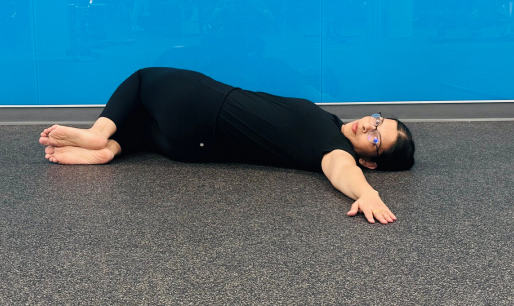
Benefits:
- Relieves tension in the back and spine.
- Improves spinal mobility and flexibility.
- Aids in digestion and detoxification.
- Promotes relaxation and stress relief.
Savasana (Corpse Pose)
Savasana (Corpse Pose) is a restorative yoga pose practiced at the end of a session to integrate the benefits of the practice. In this pose, you lie flat on your back with arms and legs extended, palms facing upward, and focus on complete relaxation. Though simple, Savasana is one of the most challenging poses, requiring full surrender of both body and mind. It calms the nervous system, reduces stress, and promotes mindfulness. This pose helps release any remaining tension, offering deep relaxation and peace. Savasana is essential for rejuvenating the body and mind after a yoga practice.
How to do it:
- Lie flat on your back with your legs extended and arms at your sides, palms facing up.
- Close your eyes and allow your body to relax completely.
- Focus on your breath, letting go of any tension or thoughts.
- Stay in this position for 5-10 minutes.

Benefits:
- Promotes deep relaxation and reduces stress.
- Helps calm the mind and nervous system.
- Encourages full-body relaxation after practice.
- Helps improve sleep quality and emotional well-being.
Conclusion: Yoga for a Healthier, More Active Lifestyle
Incorporating yoga into your daily routine is a wonderful way to break free from the harmful effects of a sedentary lifestyle. These simple poses help stretch and strengthen the muscles, improve posture, and enhance flexibility. They also reduce stress and promote mental clarity—essential for maintaining productivity and well-being.
Even if you can’t find a lot of time in your day, dedicating just 15-20 minutes to yoga can make a significant difference. So, start practicing these poses and experience the benefits of a more active and balanced lifestyle!
Even if you can’t find a lot of time in your day, dedicating just 15-20 minutes to yoga can make a significant difference. So, start practicing these poses and experience the benefits of a more active and balanced lifestyle!
